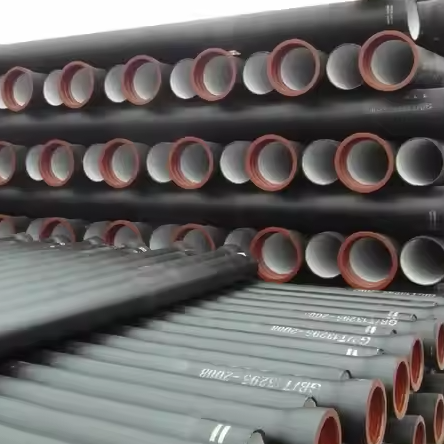Cement lining in ductile iron pipes is a time-tested solution, dating back to the 1920s, designed to protect the pipe’s interior from electrochemical corrosion (tuberculation) and to maintain water quality through a high-pH, smooth barrier layer. Standardized under ANSI/AWWA C104/A21.4, cement-mortar lining ensures durability, hydraulic efficiency (Hazen-Williams coefficient of 140), and compliance with potable water regulations (NSF 61). Applied via centrifugal or projection methods, this lining extends service life, reduces maintenance costs, and mitigates tuberculation, making it the industry benchmark for water and wastewater distribution systems.

1. Introduction
Ductile iron pipe, known for its strength and resilience, has been a cornerstone in water distribution since the early 20th century. Manufacturers began applying cement-mortar lining as early as the 1920s to combat internal corrosion. Over decades of field performance, cement-lined pipes have demonstrated exceptional longevity and hydraulic performance in potable and non-potable applications alike.
2. Purpose of Cement Lining
2.1 Corrosion Prevention
Cement lining acts as a physical barrier, preventing direct contact between water and the iron substrate, thereby inhibiting iron oxide formation (tuberculation).
2.2 pH Control
The high alkalinity at the cement-pipe interface raises the local pH, creating an environment hostile to corrosive reactions.
2.3 Hydraulic Efficiency
A smooth cement surface yields a Hazen-Williams flow coefficient of up to 140, reducing head loss and energy costs in pumping systems.
3. Standards and Specifications
| Standard | Scope | Certification |
|---|---|---|
| ANSI/AWWA C104/A21.4 | Cement-Mortar Lining for Ductile-Iron Pipe and Fittings for Water Service | NSF 61 approved (potable) |
| ANSI/AWWA C150/A21.50 | Thickness Design of Ductile-Iron Pipe | — |
| ANSI/AWWA C151/A21.51 | Ductile-Iron Pipe, Centrifugally Cast for Water | — |
| ASTM G62 | Standard Test Method for Surface Chemical Analysis of Cement-Mortar Lined Pipes | — |
Cement lining thicknesses and weights follow AWWA C104 guidelines, typically tapering at the pipe ends to ensure proper joint sealing.
4. Application Process
-
Centrifugal Method: The pipe rotates, and mortar is cast against the interior wall by centrifugal force, ensuring uniform thickness.
-
Projection Method: Mortar is pneumatically projected onto the pipe’s interior, suitable for larger diameters or repair applications.
Both methods guarantee adhesion and compaction, critical for long-term performance.
5. Benefits of Cement-Lined Ductile Iron Pipe
| Benefit | Description |
|---|---|
| Corrosion Resistance | Prevents tuberculation and pitting by isolating water from the metal surface |
| Hydraulic Efficiency | Maintains a smooth surface (C-factor 140), reducing energy costs |
| Longevity | Proven service life of 50+ years in demanding environments |
| Water Quality | Minimizes release of iron and contaminants, preserving taste and clarity |
| Low Maintenance | Reduces the frequency of cleaning and relining operations |
6. Limitations and Considerations
-
Mechanical Damage: Cement lining can chip under extreme bending or impact, requiring field repairs per AWWA C104 instructions.
-
Deterioration in Aggressive Water: High anion concentrations (e.g., reclaimed water) may erode the lining, increasing corrosion risk if not monitored.
-
Initial Water Quality Impact: New lining may release fine cement particles; flushing procedures are recommended before commissioning.
7. Comparison with Alternative Linings
| Feature | Cement-Mortar Lining | Epoxy Coating | Polyethylene Encasement |
|---|---|---|---|
| Corrosion Control | Excellent (High pH barrier) | Very Good (Chemical barrier) | Interior protection only |
| Hydraulic Performance | Smooth surface (C=140) | Smooth (C=130–140) | No interior lining effect |
| Application Cost | Moderate | Higher | Additional material + labor |
| Repairability | Easy (Patchable in field) | Requires professional repair | Not applicable |
| Certification | NSF 61, AWWA C104 | NSF 61, AWWA C116 | AWWA C105 |
8. FAQ
Q1: Why is cement lining used in ductile iron pipes?
A: It prevents internal corrosion (tuberculation) by creating a high-pH, physical barrier between water and iron.
Q2: What does AWWA C104 specify?
A: ANSI/AWWA C104/A21.4 details the requirements for cement-mortar lining materials, thickness, application, and quality control for water service.
Q3: How thick is the cement lining?
A: Standard thickness ranges per AWWA C104; typical minimum is 0.01 in./in. of pipe diameter, tapering at pipe ends.
Q4: Can the lining be repaired if damaged?
A: Yes, field repairs follow the procedures outlined in AWWA C104, using matching mortar and surface preparation.
Q5: Does cement lining affect hydraulic performance?
A: It enhances performance, maintaining a Hazen-Williams C-factor of 140 for efficient flow.
References:
- ANSI/AWWA C104/A21.4 – Cement-Mortar Lining for Ductile-Iron Pipe and Fittings
- NSF International – Drinking Water System Components Certification (NSF/ANSI 61)
- Ductile Iron Pipe – Wikipedia (History and Applications of Cement Lining)
- ASTM G62 – Standard Test Method for Surface Chemical Analysis of Cement-Mortar Lined Pipes
- U.S. Environmental Protection Agency (EPA) – Water Quality and Pipe Materials Guidance
